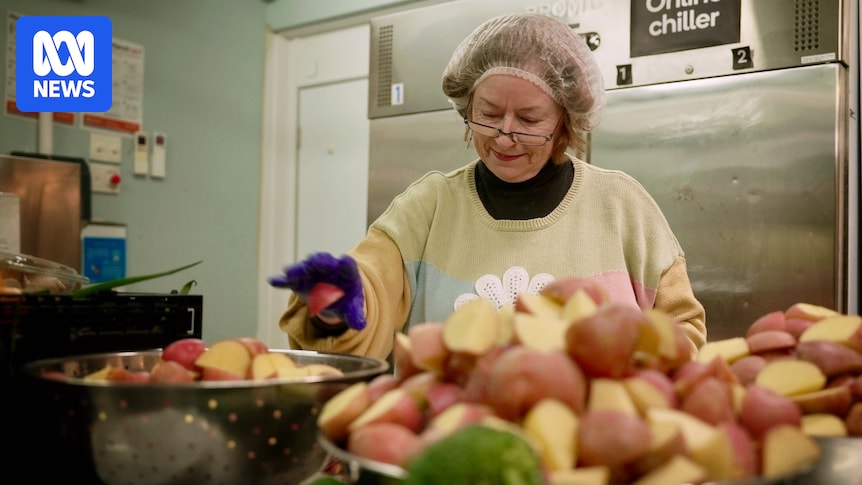In Australia, the pension age was lifted from 65 to 67 in 2023.
For some manual workers, it’s a physical struggle to continue working until 67.
“For some, 67 is an achievable and even desirable pension age,” said Professor Gary Martin, workplace specialist at the Australian Institute of Management.
“For others, the road there is far more demanding.”
Carpenter and labourer Paul Quealy has some advice for young tradies.
Paul Quealy recently had a skin cancer removed from his nose. (ABC News: Jak Rowland)
“Save as much as you possibly can before you get to the age of 55 because it’s a long way to the pension and it can be a lot of pain as well,” he said.
The 60-year-old recently had a skin cancer removed from his nose and needed a skin graft.
He is physically unable to work a full week.
“I’ve recently had checks on my knees and the cartilage is worn out in my joints, including my shoulder, and it’s due to lifting heavy weights,” he said.
His doctor suggested he could apply for a disability pension.
But Mr Quealy would like to continue to work part-time, though finding a job has been a struggle.
“You hit 55 and you feel like nobody wants you anymore. I think it has a mental impact on you,” he said.
Mr Quealy worked as a carpenter and labourer. (ABC News: Jak Rowland)
Mr Quealy would like to see the pension age adjusted for people who have worked in physical jobs, including nurses and aged care workers.
He would also like there to be financial help for manual labourers needing work-related surgery, such as a knee replacement, so they can access private health care rather than having to wait through the public hospital system.
“So you can get back to work and support your family,” he said.
“Perhaps there should be some means-tested dispensation for people who can’t afford expensive doctor’s bills.”
Considering cheaper retirement overseas
Petia McClenaghan would also like to see the age pension lowered.
“For physical workers [67] is completely unsustainable. It’s just too hard,” she said.
The former tuck shop manager said heavy lifting and constantly being on her feet had taken a toll.
“There was absolutely no way I could continue to do what I did, I was having degeneration in my hips and shoulders,” she said.
The 58-year-old has minimal superannuation and is having to manage on a JobSeeker payment.
Although Ms McClenaghan retrained in business administration, she has been unable to find work.
The former tuck shop manager said heavy lifting and constantly being on her feet have taken a toll. (ABC News: Mark Leonardi)
“I just felt I was being passed over.”
Do you know more? Contact Fiona Blackwood at blackwood.fiona@abc.net.au.
Ms McClenaghan said that despite having “a generous landlord”, her rent amounts to 80 per cent of her Centrelink allowance.
“I say to people, ‘I am one rent increase away from homelessness’ and I know that sounds very drastic but I literally am,” she said.
Ms McClenaghan volunteers with Compassion for Community, an organisation that provides meals for those in need.
Not everyone works until retirement age. What are the options?
Through her work she can take home a free meal and on occasion, excess produce.
She said she does not want to “get ahead”, she just wanted to survive.
It has brought her to consider retirement overseas, where the cost of living is cheaper.
Places such as Vietnam, Thailand and Albania are all options.
“Anywhere where I can sustain housing and continue to survive on lesser amounts of money,” she said.
Staggered pension age a solution
Professor Martin said there was a strong case for flexibility in the pension age for those in physically demanding jobs.
“Such flexibility could include staggered pension ages, occupation-specific provisions or partial pensions for those unable to continue to work full time,” he said.
Professor Martin said superannuation did not always come to the rescue for those who needed to finish work earlier.
“While estimates differ, many people forced to retire in their mid to late-50s have accumulated only $200,000 to $350,000. Some, far less,” he said.
Having to give up work early due to physical constraints could result in using up superannuation sooner and being worse off financially.
Professor Martin says many Australians will spend their retirement managing chronic illness or disability. (ABC News: Nicholas Martyr)
Professor Martin said older workers wanting to retrain or find different work often faced barriers.
“Age bias can quietly edge out older workers from opportunities, with skills and experience too often overlooked in favour of younger recruits,” he said.
And while the financial cost of retiring early must be addressed, the possibility of a shorter life expectancy due to years of physical work or its impact on an enjoyable retirement should also be considered.
“Some Australians will enjoy many years of good health after retirement while others will spend much of that time managing chronic illness or disability,” he said.
A spokesperson from the Department of Social Services said age pension eligibility was set consistently across the community.
“It is not linked to a person’s past employment type, occupational history, or other social determinants, and the government has no plans to change this,” they said.
“The social security system is designed to support those who need it most, while also ensuring it can be sustained for future generations.”
Loading…

